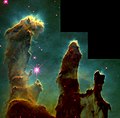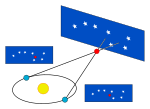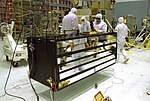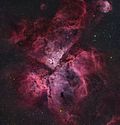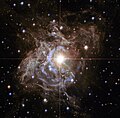The Wide Field Camera 3 (WFC3) is the Hubble Space Telescope's last and most technologically advanced instrument to take images in the visible spectrum...
9 KB (1,019 words) - 19:43, 10 May 2024
The Wide Field/Planetary Camera (WFPC) (pronounced as wiffpick (Operators of the WFPC1 were known as "whiff-pickers")) was a camera installed on the Hubble...
6 KB (596 words) - 10:33, 25 July 2023
The Wide Field and Planetary Camera 2 (WFPC2) is a camera formerly installed on the Hubble Space Telescope. The camera was built by the Jet Propulsion...
8 KB (940 words) - 07:48, 27 February 2023
Planetary Camera 2 (1993–2009) Wide Field Camera 3 (installed 2009) Wide Field Camera, at the Isaac Newton Telescope in the Canaries Wide Field Camera, aboard...
356 bytes (83 words) - 18:39, 29 July 2023
exposures taken in 2002 to 2012 with Hubble's Advanced Camera for Surveys and Wide Field Camera 3, it shows some 10,000 galaxies. On January 23, 2019, the...
20 KB (2,187 words) - 01:50, 2 July 2024
been re-oriented for publication. The Wide Field and Planetary Camera 2 was replaced by the Wide Field Camera 3, and the former was taken back to Earth...
16 KB (1,663 words) - 18:21, 20 September 2024
the Hubble Space Telescope. The view was captured by the then-new Wide Field Camera 3, though the region was also viewed by the previous generation instrument...
4 KB (306 words) - 22:29, 14 March 2024
in 2008, and has been largely replaced by the infrared channel of Wide Field Camera 3 after its installation in 2009. The infrared performance of the Hubble...
17 KB (1,759 words) - 13:35, 23 June 2024
discovery occurred in April 2015, using the Hubble Space Telescope's Wide Field Camera 3, and its discovery was announced on 26 April 2016. S/2015 (136472)...
13 KB (1,272 words) - 04:52, 22 July 2024
Hubble Space Telescope (redirect from Frontier Fields)
(non-operative 2004–2009)) Wide Field and Planetary Camera (WFPC; 1990–1993) Wide Field and Planetary Camera 2 (WFPC2; 1993–2009) Wide Field Camera 3 (WFC3; 2009–present)...
219 KB (21,787 words) - 10:05, 15 October 2024
was first identified in archival Hubble images taken with Hubble's Wide Field Camera 3 on 18 September 2010. Its discovery was reported and announced by...
18 KB (1,427 words) - 18:05, 8 July 2024
STS-125 (section May 13 (Flight day 3))
Hubble Space Telescope, the Cosmic Origins Spectrograph and the Wide Field Camera 3. The mission also replaced a Fine Guidance Sensor, six gyroscopes...
116 KB (10,916 words) - 00:01, 30 September 2024
A light field camera, also known as a plenoptic camera, is a camera that captures information about the light field emanating from a scene; that is, the...
26 KB (2,543 words) - 04:11, 31 July 2024
star, a white dwarf, was identified in 2009, using the upgraded Wide Field Camera 3 on board the Hubble Space Telescope. The star has a current mass...
11 KB (1,230 words) - 04:48, 15 May 2024
optics). Also using reflecting optics, the Hubble Space Telescope with Wide Field Camera 3 can observe in the frequency range from about 0.2 μm (0.0002 mm)...
41 KB (3,925 words) - 14:00, 27 September 2024
stars out to a few hundred parsecs. The Hubble Space Telescope's Wide Field Camera 3 has the potential to provide a precision of 20 to 40 microarcseconds...
35 KB (5,006 words) - 04:32, 15 September 2024
stars out to a few hundred parsecs. The Hubble Space Telescope's Wide Field Camera 3 has the potential to provide a precision of 20 to 40 microarcseconds...
24 KB (3,841 words) - 01:14, 28 August 2024
Deep Survey-North (GOODS-North). The research team used Hubble's Wide Field Camera 3 to measure the distance to GN-z11 spectroscopically, measuring the...
15 KB (1,228 words) - 18:04, 2 August 2024
converge more due to the wider total field. For example, buildings appear to be falling backward much more severely when the camera is pointed upward from...
12 KB (1,561 words) - 05:37, 4 February 2024
Spectrograph Wide Field and Planetary Camera Wide Field and Planetary Camera 2 Wide Field Camera 3 McKee, Maggie. "NASA attempts to revive Hubble's main camera"....
12 KB (1,272 words) - 19:11, 13 February 2024
Space Shuttle mission to the Hubble) which carried an IMAX 3D camera. The IMAX 3D camera contained a mile of film, though this allowed for only 8 minutes...
6 KB (519 words) - 15:06, 13 October 2024
November 2021. Retrieved 4 June 2021. "Hubble Space Telescope – Wide Field Camera 3". NASA. 22 August 2016. Archived from the original on 13 November...
213 KB (19,829 words) - 16:04, 3 October 2024
(See also sungrazer.) In 2010, between January and May, Hubble's Wide Field Camera 3 took images of an unusual X shape originated in the aftermath of...
107 KB (12,087 words) - 19:00, 28 August 2024
Panoramic photography (redirect from Panoramic camera)
(APS) cameras use the word "panoramic" to define any print format with a wide aspect ratio, not necessarily photos that encompass a large field of view...
33 KB (3,731 words) - 04:46, 27 August 2024
Transmission Spectroscopy of the Exoplanets HD 209458b and XO-1b Using the Wide Field Camera-3 on the Hubble Space Telescope". Astrophysical Journal. 774 (2): 95...
37 KB (3,919 words) - 01:13, 17 July 2024
Telescope on its 20th anniversary. The area was observed by Hubble's Wide Field Camera 3 on 1–2 February 2010. The pillar measures three light-years (0.92 pc)...
36 KB (3,723 words) - 19:37, 4 August 2024
rotation. The wide equatorial zone rotates with a period of about 18 hours, which is slower than the 16.1-hour rotation of the planet's magnetic field. By contrast...
147 KB (14,339 words) - 17:20, 17 October 2024
as photographic film. As a pivotal technology in the fields of photography and videography, cameras have played a significant role in the progression of...
58 KB (6,842 words) - 16:08, 10 September 2024
(2014). "Parallax beyond a Kiloparsec from Spatially Scanning the Wide Field Camera 3 on the Hubble Space Telescope". The Astrophysical Journal. 785 (2):...
38 KB (4,299 words) - 06:07, 13 October 2024
fourteen sets of images taken between 26 June and 9 July 2012 by the Wide Field Camera 3 fitted to the Hubble. The discovery was announced on 11 July 2012...
20 KB (1,732 words) - 11:59, 8 September 2024





